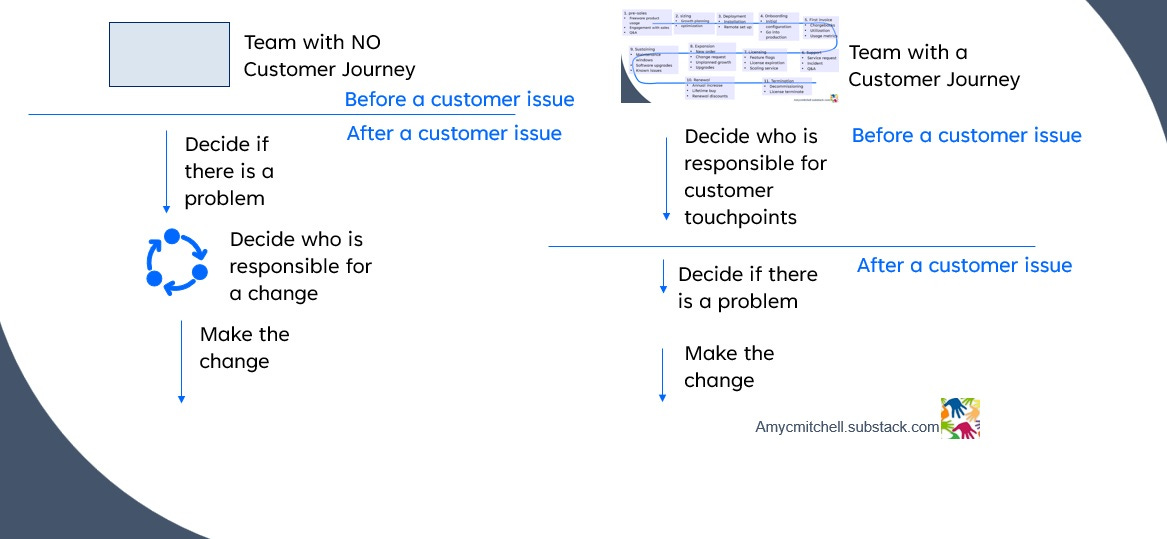A Case Study on Customer Journey Maps
Overcoming product challenges through customer journey mapping
Do you cringe at the idea of making a customer journey map for your product? Your busy product team won’t use it and your stakeholders only care about results. Why spend your limited product management effort on a customer journey map?
Customer journey maps and examples are covered in this article: Customer Insights with a Customer Journey Map
Let's dive into a case study of a product with no customer journey map.
Case Study Background
A high-growth software product runs on virtualized servers in global enterprises. The product has a unique installation sequence to enable data protection at all times.
Customers were having trouble installing the software. Customers would contact support when the installation wasn't working. The support team usually re-installed the software and closed the support case.
Customers were raising concerns that the software installation was too complex.
The Challenge for the Product
The Engineering response to the customers' concern was:
Customers aren't following the installation document
Customers have an old version of the virtualization platform
Customers can't recreate the problem since support had to re-install the software quickly
The customer support team confirmed that they couldn't collect logs or other information that would allow recreation of the installation issues
Customers were upset about the delays in installing the software since maintenance windows had to be extended. Engineering acknowledged that the customer experience wasn't ideal.
Engineering's position: can't fix something that can't be recreated.
Breaking Through the Challenge
After additional customer installations failed and a key customer exceeded their maintenance window, the team couldn't ignore the problem any longer.
The product manager requested a code change to dump the system state periodically during an installation.
Engineering rejected this idea - a dump of debug information didn't seem worth the effort. Who would evaluate the dump of debug information?
As more support cases piled up, the product manager brought the issue to the product team. The test team stepped up to evaluate the dump of debug information.
With this breakthrough, the code was changed - it was a feature flag setting. The test team evaluated the dump of debug information. The test team found issues to fix. As more customers upgraded, the installation issues were reduced significantly.
How Does This Relate to a Customer Journey Map?
Product teams with a high-growth product, often don't have time to develop a customer journey map. However, cross-functional issues are tricky to handle for product managers. When issues touch multiple teams, then product managers perform some of the steps in creating a customer journey map.
Building a part of the customer journey map in the middle of a customer problem delays getting a solution to the customer.
Case Study With A Customer Journey Map
Suppose on this same product, the product manager had developed a customer journey map. Below is a simple map the product manager created:
As part of creating this customer journey map, the product manager got agreement on the key customer touchpoints with the product team. One key touchpoint is the customer doing the install - #3.
The product manager got some other benefits from the customer journey map:
Learned about the cross-functional roles that support the customer journey
A shared understanding of the key customer touchpoints
Linkage of the customer journey to key business objectives
Product team roles established
How Could a Customer Journey Map Help on this Case Study?
In this case study, the customer journey map could have reduced the time to resolve the customer issue. The product team roles, customer touchpoints, and business-impacting metrics would have been established with the customer journey map.
Without a customer journey map, the product team spent investigation time deciding if the problem needed to be fixed and team responsibilities.
With investment in the customer journey map, the product team could quickly decide the problem needed fixing and make the change in less time.
Conclusion - Customer Journey Maps Are For Product Managers
Product managers get a lot of value by visualizing the customer experience in a customer journey map. The lessons learned from this case study are:
A joint solution is best: The product team solves the customer's issue together
Relationships matter: cross-functional teams get to know each other through the customer journey map
Shared understanding sparks teamwork: the faster the product team understands the problem, then the faster the issue is resolved
The framework of the customer journey map led to foundational knowledge of a good customer experience for the whole product team. Investing in customer journey maps helps product managers.
Want to know what happened after a recent article? Premium subscribers get a peak behind the scenes of a recent newsletter. Last week’s backstory was about keeping momentum on your product when a high-priority project hits. Balancing Old and New Requests in Product
Connect to Amy on LinkedIn, Threads, Instagram and X/Twitter








Thanks, Amy!
I like to use journey maps to indicate pains and sentiments for each touch point as well. It is a great basis for discussion.